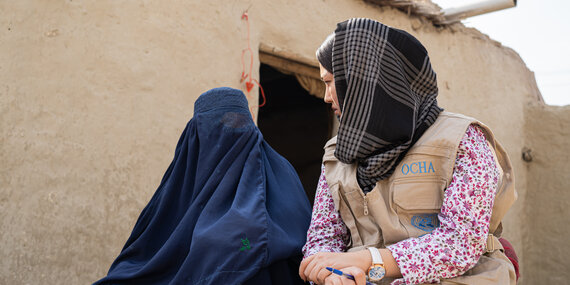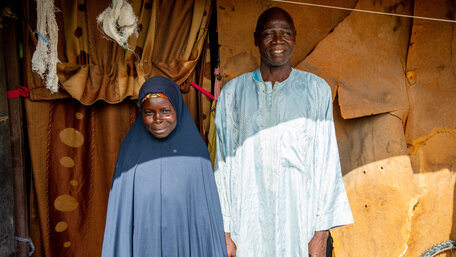Jalalabad, Afghanistan
A humanitarian worker talks with a woman displaced to the Surkh Rod area in Nangahar Province. The community will receive core relief items to help them during the winter. Implementing partner IMC is delivering the aid, supported by the Afghanistan Humanitarian Fund. OCHA/Charlotte Cans
Accountability to affected people (AAP) and protection from sexual exploitation and abuse (PSEA) must remain firmly embedded in every humanitarian response. Humanitarian action is accountable to the women, men, girls, and boys – of all ages and abilities – affected by humanitarian crises. It is critical that their voices are heard and that they have active participation in all areas of response that affects their lives and well-being.
New or escalating humanitarian crises in Ethiopia, Afghanistan, Myanmar and Haiti, and persisting crises in Syria, Yemen, South Sudan and DRC have reinforced the need for robust community engagement and accountability in 2021. Strong measures are required to prevent, respond to and mitigate the risks of sexual exploitation and abuse to ensure that humanitarian operations are safe and effectively respond to the needs and priorities of all affected people.
Health emergencies such as the COVID-19 pandemic cause vulnerabilities to grow and the risks of gender-based violence and sexual exploitation and abuse increase. As the COVID-19 crisis persisted in 2021, adding to the needs and challenges of 2020, risks of SEA were further compounded and are likely to continue into 2022.
System-wide accountability across Asia and the Pacific
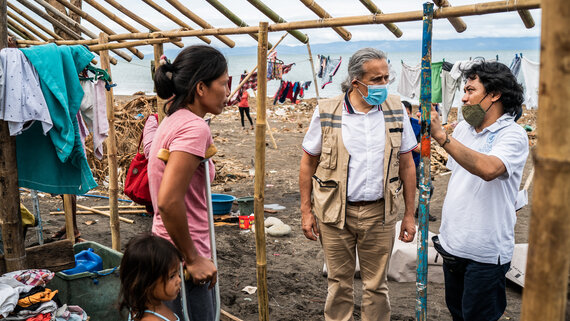
In 2021, a collective workplan was developed to improve the commitment to and implementation of system-wide accountability across the Asia-Pacific region. Developed by the Asia-Pacific Inter-Agency Coordination Group on AAP and PSEA and endorsed by the IASC Regional Directors, the workplan included nine strategic workstreams to ensure countries and operations establish and roll out collective AAP and PSEA strategies and action plans. Comprising over 160 regional and country experts from 18 countries, the Coordination Group provides intensive support that includes capacity-building, mentoring, knowledge exchange and design of accountability toolkits to improve humanitarian responses. The group is also partnering with a start-up organization to support the design of an inter-agency platform for community feedback and complaints. Indonesia, Myanmar, Nepal and the Philippines are also exploring the use of such a system.
In the picture, Gustavo Gonzalez, UN RC/HC in the Philippines, talks with a woman during a visit to Albay Province, a week after it was battered by Super Typhoon Goni.
OCHA/Martin San DiegoDevelopments in policy and operations
AAP is vital to realign the asymmetry of power that currently defines the relationship between humanitarian agencies and communities. It is essential to meet long-standing organizational and collective standards and commitments, including through the work of the Grand Bargain. In 2021, the IASC Principals agreed to issue a statement on the centrality of collective AAP to principled humanitarian action, based on the recommendations to strengthen system-wide accountability produced by the IASC Operational Policy and Advocacy Group (OPAG). Throughout 2021, the Results Group 2 on Accountability and Inclusion provided technical support, guidance and tools to humanitarian leaders and responders through the Portal and Service Directory, which strengthens AAP at the country level, including in the HPC.
During 2021, an increased proportion (32 per cent) of HCTs have reported having a collective AAP strategy or framework in place. Forty per cent have either a framework, working group or coordination mechanism. Three regional inter-agency AAP coordinators are working as AAP/PSEA focal points in OCHA offices in Latin America and the Caribbean, Asia Pacific, and Southern and Eastern Africa. Each coordinator supports countries and operations by providing strategic and technical support. AAP is included in 27 HRPs.
PSEA is a core part of the humanitarian system’s commitment to AAP and the ‘do no harm’ approach. It should be integrated as a priority cross-cutting component of every humanitarian response.
A tool to express needs and priorities of the affected people in Ethiopia
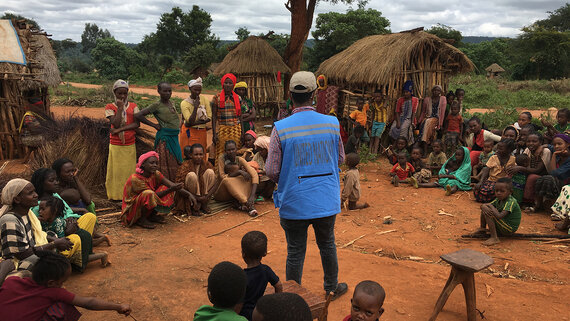
In Ethiopia, the Collective Platform for Community Voices is an inter-agency tool to respond to the expressed needs and priorities of affected people. With wide input from humanitarian agencies and NGOs, the platform was endorsed by the Ethiopia HCT. The platform analyses data provided by organizations on the current needs and challenges of affected people within the humanitarian response. Insights are provided, which help humanitarian responders make decisions and adapt programming. The Collective Platform comprises three sections that include:
-
Community voices: an interactive dashboard provides details related to a number of variables, disaggregated by age, gender and other vulnerability characteristics, to understand the needs and priorities of the affected communities by location.
-
Recommendations for actions: for humanitarian responders and decision makers, including the Ethiopia HCT, Inter-Cluster Coordination Group, Humanitarian International Non-Governmental Organizations Network and other relevant coordination forums, to act upon community feedback.
-
Corrective actions: documents key milestones, including successes and challenges, on how agencies and decision makers have made course corrections in response operations.
The platform will be updated each month to ensure that real-time feedback from communities informs the response planning and decision-making process.
In the picture, a humanitarian worker meets with the local community in Melka Soda Woreda, Ethiopia.
OCHA/Jordi CasafontThe IASC Plan for Accelerating PSEA in Humanitarian Response calls for strengthened collective action at the country level. PSEA networks are required to produce joint annual UNCT/HCT PSEA action plans to strengthen SEA prevention and response at the country level. The percentage of PSEA networks with an action plan in place has increased from 58 per cent in 2019 to 76 per cent in 2021. In 2021, inter-agency PSEA coordinators provided technical and strategic support in more than 20 countries. In complex emergencies, such as Ethiopia and DRC, PSEA coordinators are also deployed to operational hubs to strengthen collective actions at the front line of response. The percentage of PSEA networks led by a PSEA Coordinator has increased to 73 per cent in 2021. However, due to funding limitations, PSEA coordinator deployments often remain short term and unsustainable.
PSEA has been increasingly integrated into the HPC, with country-level PSEA priorities, coordination and activities reflected in 24 HRPs in 2021. The percentage of PSEA networks that have integrated PSEA into HRPs has increased to 70 per cent in 2021. Despite this, there is still limited consideration of funding for PSEA activities, with only eight countries including PSEA funding through HRPs in 2021. PSEA actions were also supported through humanitarian pooled funds in CAR, DRC, Ethiopia and Lebanon, while CERF funds were used for Ethiopia, Haiti, Mali, Somalia and Nigeria. Other operations obtained funding from donors or UN agencies. The IASC PSEA Field Support Team, comprised of UN entities and NGOs, continues to provide dedicated technical support and advice to strengthen PSEA programmes in priority-country contexts.
IASC External Review of PSEAH
The IASC Independent External Review on Protection from Sexual Exploitation and Abuse and Sexual Harassment (PSEAH) is sponsored by UNFPA as IASC 2021 PSEAH Champion. It was initiated to identify successful collective efforts over the last decade and to recommend further collective action for improvement. The review provides recommendations to the IASC leadership and broader humanitarian system to: ensure a common action plan on PSEAH; address the lack of accountability and improve investigations, and ensure funding for PSEA programmes in 15 priority contexts where SEA risks are the highest, to ensure sustained support for and implementation of PSEA measures. The review also emphasizes that SEA risk management and mitigation is integrated into all areas of the humanitarian response and support for SEA victims and survivors should be scaled up.
Gaps in funding
AAP and PSEA approaches still struggle to secure predictable, multi-year, flexible funding across the HPC even though few resources are required to lead to the more effective and accountable programming needed to adapt to feedback and allow for more iteration, learning and time to build trust within communities. AAP and PSEA coordinator deployments are predominantly reliant on short-term funding, which makes planning and implementation unsustainable.
Funding allocations strengthen PSEA in DRC and CAR
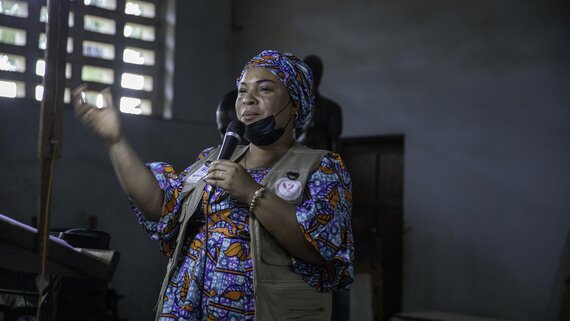
In DRC, a $1.5 million allocation to the DRC Humanitarian Fund has strengthened ways for survivors to submit complaints safely and confidentially through a toll-free hotline. Operators have received training, and survivors are using the hotline to report their cases and seek assistance. The allocation also provides for medical supplies for survivors through established GBV services. The same project aims to prevent and mitigate SEA risks in newly emerging crises. During the October 2021 Ebola outbreak and the Angola-returnees crises, front-line aid workers received PSEA training. Women-led and community-led associations helped establish and strengthen community-based complaints mechanisms; PSEA focal points conducted risk assessments; and awareness-raising campaigns were implemented through mass media. Capacity-building for investigations is planned for local NGOs in dire need of guidance and support.
In CAR, a $4.1 million CBPFs allocation has strengthened prevention and response in active-conflict areas, IDP sites and hard-to-reach areas, where women and girls are particularly exposed to GBV and SEA. This includes $3.25 million to projects that provide psychosocial, economic, medical and legal support to survivors of GBV and SEA, and $742,000 to purchase post-exposure prophylaxis kits and provide capacity-building for health experts who manage rape cases.
In the picture, the coordinator of a local NGO talks to a crowd during a workshop in Kananga to empower women victims of GBV. In central Kasai, whenever a woman has a relationship outside of marriage, she must pay a fine to the customary chief in order to be able to return to her home. The NGO succeeded in obtaining the commitment of customary chiefs to "alleviate" the fines imposed on women by custom. This is a first step in a deeply traditional area.
OCHA/Alioune NdiayeWays forward
If humanitarian actors are to meet individual agency- and system-wide PSEA and AAP commitments, three areas require immediate action:
-
An enhanced and more accountable response leadership of HCs and HCTs that is adequately supported and prioritizes collective AAP and PSEA in HCT compacts and performance appraisals.
-
A more inclusive architecture that builds on existing coordination structures, supports more area-based coordination approaches, and includes and supports local leadership (particularly national women-led and women’s rights organizations), including within the HCT.
-
Adequate quality funding for in-country collective approaches and for the creation of dedicated PSEA and AAP capacity to support United Nations Resident Coordinators/Humanitarian Coordinators (RC/HCs), and to further develop available technical capacity through collective inter-agency mechanisms.
Further reading
Source: IASC
Source: IAWG Ethiopia
References
- AAP is co-chaired by OCHA and Plan International; PSEA is co-chaired by IOM, UNFPA and UNICEF.
- See Note on IASC coordination structures at country level in 2020
- Calculation is based on an average of 33 countries with humanitarian crises reporting to the IASC PSEAH Dashboard on key indicators annually.
- The number of PSEA coordinators deployed varies throughout the year due to funding availability, contract modalities and other factors.
- Calculation is based on an average of 33 countries with humanitarian crises reporting to the IASC PSEAH Dashboard on key indicators annually.
- Ibid

